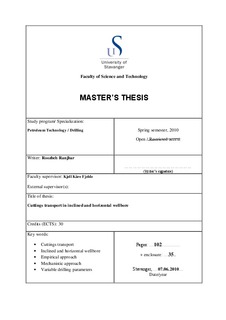| dc.description.abstract | Efficient cuttings transport and hole cleaning is very important for obtaining an effective drilling operation. In inclined and horizontal drilling, hole cleaning issues is a common and complex problem. This thesis explores the impact of various drilling parameters, and how they affect the required flow velocity and flow rate required for effective cuttings transport.
The main objectives of the thesis are outlined as follows:
- To make a sufficient review of previous studies;
- Explain the fundamentals of the cuttings transport parameters and definitions;
- To introduce and explain in great details the empirical model focusing on the models of Larsen and Rubiandini;
- To make an introduction to the mechanistic modeling approach focusing on demonstrating the complexity of these models;
- To apply Larsen‟s and Rubiandini‟s models in order to compare and identify similarities and differences between the models;
- To present some field experience from offshore;
- To draw conclusions about what we can learn from earlier studies and research.
The thesis employs two models developed by an empirical approach, namely Larsen‟s model and Rubiandini‟s model. Two simulation scenarios have been considered. First, we have compared the models using the cases defined by Larsen from his experimental work. Then, an example well has been considered which mimics more operational conditions. Moreover, the thesis presents the mechanistic two-layer model developed by Kamp and Rivero, and demonstrates how the model has to be reformulated mathematically before a numerical method can be used for solving the model.
The analysis of the two empirical models showed that both models show the same trend for required cuttings transport flow velocity and flow rate when drilling parameters, such as mud weight, ROP, mud rheology and drill-pipe diameter varied. For the horizontal case, we observe that Larsen predicts flow rate that are not far from the flow rates typical seen in operations, however it slightly over predicts required cuttings transport velocity. Rubiandini‟s model seems to predict high flow rate required for cuttings transport. However, for the vertical case, the predicted rate seems to coincide with flow rates typical in operations. The main advantage of Rubiandini‟s model is that in his work, he considered RPM as a variable that could affect the cuttings transport.
The results also indicate that Larsen‟s model and Rubiandini‟s model show the opposite effect on required cuttings transport velocity when the cuttings size is a variable parameter. In the Larsen‟s model, smaller cuttings required higher flow velocity to be transported, while in the Rubiandini‟s model, the opposite is observed, namely larger cuttings need a higher flow velocity for transport in the wellbore.
In the conclusion, several recommendations on how to achieve better cuttings transport and hole cleaning are listed. | en_US |
